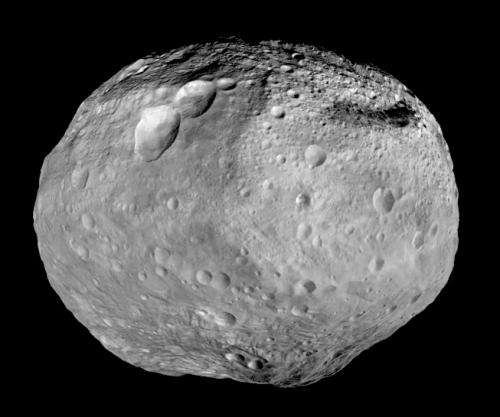Asteroid Vesta more like Earth than realized, study shows

The cold, dead asteroid Vesta might have had a very active inner life early in the solar system's history, according to an unusual analysis of a Saharan meteorite.
Vesta might have had a magma ocean underneath its rocky exterior, allowing bits of mineral to rise and fall between softer and harder layers of material, according to a study published online Sunday by the journal Nature Geoscience. If confirmed, that would make it more like Earth and the solar system's other rocky planets than scientists had realized.
The report provides a fresh look at the protoplanet, supplementing data sent back from Vesta by NASA's Dawn spacecraft.
"People think asteroids are big, gray, cold, almost potato-shaped lumps of rock that sometimes crash into the Earth and threaten us," said study leader Beverley Tkalcec, a planetary geologist at Goethe University in Frankfurt, Germany. Instead, she said, "it has a dynamic interior similar to what might have been at the beginning of the Earth."
Hot or not, Vesta is one big potato, about the size of Arizona. It was big enough to have experienced melting inside, causing the heavier material to sink to the center and the lighter stuff to rise to the crust.
Vesta and the dwarf planet Ceres - the next target for the Dawn spacecraft - represent planetary embryos that never fully formed. And since their rocks haven't been chewed up by ongoing tectonic processes, as Earth's have, they can be nearly as old as the solar system, which came into being more than 4.5 billion years ago.
The new study, by a trio of European scientists, is based on an examination of a meteorite called NWA 5480 that is thought to have been carved out of Vesta's mantle by an impact with another asteroid. The meteorite, called a diogenite, was found in northwest Africa, and it is part of a family of space rocks that are linked to the asteroid by their chemical and isotopic composition.
Unlike other studies, which focus on what a meteorite is made of, Tkalcec's team concentrated on how the stuff inside this meteorite was arranged. If Vesta had been active beneath the surface, the mineral structure of this sample would show some clues, they thought.
The researchers used a technique called electron backscatter diffraction, which involves bouncing electrons off a crystal to reveal the shape of its structure. They focused on a mineral in the meteorite called olivine. Instead of looking like the crystals had piled up regularly on top of one another, they found that the crystal lattice looked deformed. Something unexpected had happened to these rocks.
So the researchers compared the meteorite's internal structure with those of rocks on Earth. They found one type with a remarkably similar pattern: igneous rocks formed by forces in Earth's mantle. This meteorite, they realized, was probably formed in a similar way - its strange structure the result of solid material sinking into the softer layers below, leaving the original rock deformed.
The researchers plugged what they learned about this meteorite into a computer model of Vesta. It showed that, under the conditions that created the meteorite, Vesta could have been filled with a magma ocean.
The inside of the young asteroid may have looked something like a lava lamp, Tkalcec said.
"When you have dense solid material over partially molten material, then it's unstable," said Harry McSween, a planetary geoscientist at the University of Tennessee in Knoxville and co-investigator for the Dawn mission. "The top's trying to become the bottom and the bottom's trying to become the top."
If true, the finding could mean that Vesta experienced some of the same internal churning as Earth - for a short time, anyway.
It pushes theories about Vesta's formation "a lot further forward," said McSween, who wasn't involved in the study. "It's a really interesting paper," he said - one that may inspire scientists to look deeper into meteorites' mineral structure for clues about the parent asteroid's history.
More information: Paper: DOI: 10.1038/ngeo1710
Journal information: Nature Geoscience
(c)2013 Los Angeles Times
Distributed by MCT Information Services





















